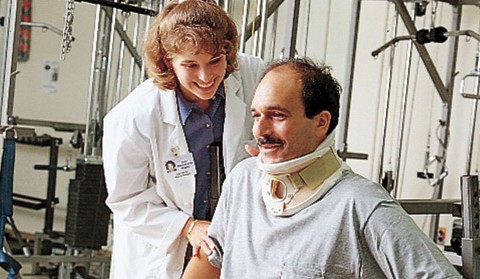Impact of the SCIRP
The SCIRP is responsible for supporting research efforts that lead to testing and validation of novel therapies for spinal cord injury. The program has attracted leading scientists and additional federal and private sector research investments to the state. The SCIRP has enhanced regional economic development and high-tech job creation by providing funds to universities, medical academic centers and hospitals throughout the state. The SCIRP has also helped to develop New York’s biotechnology industry. Several states have followed New York’s lead, including California and New Jersey
The SCIRP Places New York at the Forefront of Spinal Cord Injury Research
Researchers at Albany’s Wadsworth Center developed a spinal nerve retraining technique that is now in clinical use to improve walking deficits.
 Drs. Jason Carmel and Jack Martin at CUNY showed that electrical stimulation benefits spinal cord injury, which has been adopted in labs around the world and is moving into clinical use.
Drs. Jason Carmel and Jack Martin at CUNY showed that electrical stimulation benefits spinal cord injury, which has been adopted in labs around the world and is moving into clinical use.
University of Rochester Medical Center researchers found that a common food additive found in M&Ms and Gatorade can partially prevent paralysis in rats with spinal cord injuries. This finding has great promise for intervention in acute spinal cord injury.
Researchers at the Rensselaer Neural Stem Cell Institute, Albany Medical College and Rensselaer Polytechnic Institute developed a biomaterial releasing growth factor that significantly improved recovery after spinal cord injury in animals, another success suitable for extension to clinical trials.
Dr. Rajiv Ratan and colleagues at the Burke/Cornell Medical Research Institute have developed robotics-based rehabilitation therapies and non-invasive stimulation of the brain to promote recovery of upper limb function in patients with chronic cervical spinal cord injuries. In two cases, individuals receiving this treatment have gone from being unable to work to rejoining the work force.
 Dr. Mark Noble and colleagues at the University of Rochester developed a novel cell therapy that promotes rapid recovery of function in models of chronic spinal cord injury, even when cells are transplanted 8 months after injury and have the human cells needed for clinical trial development in hand. Combined with efforts of Dr. Ratan, these efforts offer a unique opportunity to promote functional recovery in many of the NYS individuals suffering from chronic spinal cord injuries.
Dr. Mark Noble and colleagues at the University of Rochester developed a novel cell therapy that promotes rapid recovery of function in models of chronic spinal cord injury, even when cells are transplanted 8 months after injury and have the human cells needed for clinical trial development in hand. Combined with efforts of Dr. Ratan, these efforts offer a unique opportunity to promote functional recovery in many of the NYS individuals suffering from chronic spinal cord injuries.
The SCIRP can reduce health care costs in New York State
Traumatic SCI to the neck can lead to paralysis of all limbs (quadriparesis). Costs of caring for someone with quadriplegia are $750,000 in the first year and more than $5 million over a lifetime. Millions in health care costs are saved by therapies that improve function by one or two spinal levels.
Repair based therapies supported by SCIRP can be given at any time after the injury and thus offer the unique opportunity to treat all patients. In contrast, even current FDA-approved approaches that must be given early after the injury reach less than 5% of patients.
SCIRP High-Tech Job Creation
State and non-state SCIRP funds support hundred of high-tech jobs in New York State, including scientists and support staff in universities, hospitals and research institutions. The SCIRP program supported approximately 200 jobs, attracted over 40 researchers from out of state and resulted in eight patents.